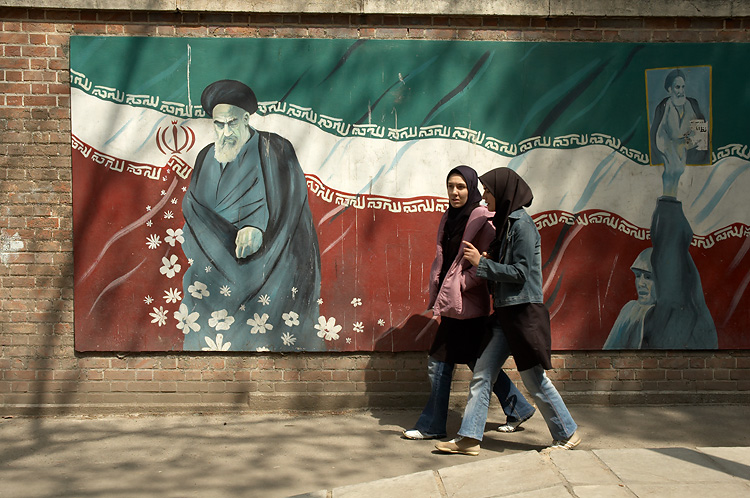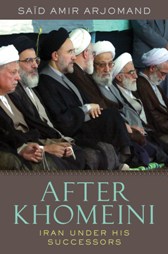
After Khomeini: Iran Under His Successors
by Said Amir Arjomand
–Reviewed by Shahnaz Habib
 “Do not allow our enemies to say that a bunch of mullahs sat there and wrote a constitution to justify their own rule. For God’s sake, don’t do this….”
“Do not allow our enemies to say that a bunch of mullahs sat there and wrote a constitution to justify their own rule. For God’s sake, don’t do this….”
In 1979, a few months after the Islamic Revolution in Iran, an Assembly of Experts was elected to translate Ayatollah Khomeini’s vision of a theocratic government into a constitution. Khomeini had mobilized Shi’ite clerics with his theory of velayat-e-faqih (“Mandate of the Jurist,” a cornerstone of Shi’ite theocratic government). But even so, there was vocal opposition from within the assembly to this ideal. The passionate plea above, by one of the dissident clerics, did not succeed, and as Said Amir Arjomand reports in After Khomeini, the Ayatollah became the Supreme Jurist of Iran. The dissent, however, has continued to shape Iranian politics.
The Iran that emerges in After Khomeini is a complex society in ferment. Rising far above the clichés that are usually invoked in writing about the country, Arjomand has created a portrait of post-revolutionary Iran that is superbly nuanced and detailed.
Arjomand begins where his previous book, The Turban for the Crown: The Islamic Revolution in Iran, leaves off. His profile of Khomeini reveals how the man behind the Islamic revolution went from a charismatic spiritual leader whose writings and teachings earned him popular respect to a ruthless politician who moved quickly to discipline his followers. Arjomand examines how in the years of power struggles since Khomeini’s death, the very idea of velayat-e-faqih, which legitimized theocratic government as a continuation of the legacy of the holy Imams, has become less influential as political thought in Iran became increasingly Sunnitized.
Arjomand argues that while the Islamic revolution was a traditionalist revolution in its motivations, the very act of practicing a tradition in a modern age transforms it. As a result, “the Islamic revolution in Iran resulted in both the traditionalization of a modernizing nation-state and the modernization of the Shi’ite tradition.” As former president and current chair of the Assembly of Experts Akbar Hashemi Rafsanjani once pointed out in Parliament, there is no legal precedent in Islam for “80 percent of the things on which we base Islamic government today.” And religious intellectuals and reformers like Abdolkarim Sorush have made it clear that the state has affected the ideals of Shi’ite Islam as well. Sorush, for example, has made a strong case for “religious democracy,” in which cultural and religious pluralism would exist alongside Islamic influence on governance. The fierce and sophisticated intellectual activism in Iran today – centered around the question of how to create an indigenous Islamic-Iranian hybrid democracy – is an activism that will shape Islam in Iran, and perhaps elsewhere.
Through his neat theoretical reversal, Arjomand identifies a practical problem: the reform movement in Iran needs to separate itself sufficiently from the revolution before it can become a powerful force. Speaking of former President Mohammad Khatami’s valiant attempts to usher in an Iranian glasnost and perestroika, Arjomand points out that “the reformists either made the tactical mistake of thinking they could appropriate the rhetoric of the Islamic revolution, or much more likely, did not have the courage to dissociate themselves from it because they were afraid of being called traitors.”
Hastily bringing the book up to speed with the most recent developments in Iran, Arjomand discusses the electoral engineering of the June 2009 elections, in which Mahmoud Ahmadinejad returned to power and protests erupted. As the Revolutionary Guard continues to clamp down on the protesters, it is impossible for the book to end on anything other than a somber note. Arjomand’s work, despite its overly broad scope and academic tone, is filled with marvelous insights and insider knowledge that, despite the book’s faults, make it an indispensable read for anyone who would like to understand what is really going on in Iran.
Excerpt: “Whatever his intention, the regime crafted by Khomeini installed the emergent political class and suited their interests admirably. But the composition of Iran’s new political class was changing as it was beginning to take shape when he died, and has changed drastically since. Numerically and otherwise, the clerical elite has been replaced by the military-security second stratum, albeit below the level of the ruling clerical councils. It is not at all clear that the present Constitution can accommodate the political amibitions of this stratum and ensure its continued harmonious relation with the clerical elite. Can clerical monarchy survive the military-security stratum’s bid for hegemony within the new political class after the reelection of its first President, Ahmadinejad, in 2009?”
Further Reading: The Ayatollah Begs to Differ: The Paradox of Modern Iran and Guardians of the Revolution: Iran and the World in the Age of the Ayatollahs
*Photo courtesy kamshots.




Send A Letter To the Editors